 W
WThe Boeing CIM-10 Bomarc was a supersonic ramjet powered long-range surface-to-air missile (SAM) used during the Cold War for the air defense of North America. In addition to being the first operational long-range SAM and the first operational pulse doppler aviation radar, it was the only SAM deployed by the United States Air Force.
 W
WThe General Dynamics FIM-43 Redeye is a man-portable surface-to-air missile system. It uses passive infrared homing to track its target. Production began in 1962 and – in anticipation of the Redeye II, which later became the FIM-92 Stinger – ended in the early 1970s after about 85,000 rounds had been built. The Redeye was withdrawn gradually between 1982 and 1995 as the Stinger was deployed, though it remained in service with various armed forces of the world until quite recently, being supplied via the Foreign Military Sales program. It was initially banned from being sold overseas, to avoid missiles falling into the hands of terrorist organizations. However, after the export ban was lifted, the weapon was never actually used by terrorists against civil aircraft, in contrast with other MANPADS. While the Redeye and 9K32 Strela-2 (SA-7) were similar, the missiles weren’t identical. Nonetheless, the CIA concluded that the Soviet SA-7 had benefited from the Redeye’s development.
 W
WThe FIM-92 Stinger is a man-portable air-defense system (MANPADS) that operates as an infrared homing surface-to-air missile (SAM). It can be adapted to fire from a wide variety of ground vehicles and helicopters. Developed in the United States, it entered service in 1981 and is used by the militaries of the United States and 29 other countries. It is principally manufactured by Raytheon Missile Systems and is produced under license by EADS in Germany and by ROKETSAN in Turkey, with 70,000 missiles produced.
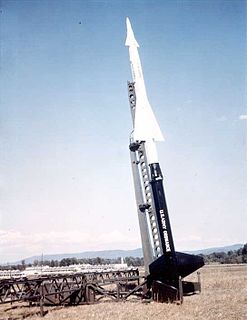 W
WThe United States Army's Nike Ajax was the world's first operational guided surface-to-air missile (SAM), entering service in 1954. Nike Ajax was designed to attack conventional bomber aircraft flying at high subsonic speeds and altitudes above 50,000 feet (15 km). Nike was initially deployed in the US to provide defense against Soviet bomber attacks, and was later deployed overseas to protect US bases, as well as being sold to various allied forces. Some examples remained in use until the 1970s.
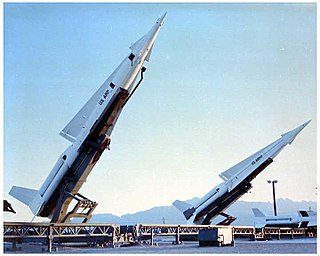 W
WThe Nike Hercules, initially designated SAM-A-25 and later MIM-14, was a surface-to-air missile (SAM) used by U.S. and NATO armed forces for medium- and high-altitude long-range air defense. It was normally armed with the W31 nuclear warhead, but could also be fitted with a conventional warhead for export use. Its warhead also allowed it to be used in a secondary surface-to-surface role, and the system also demonstrated its ability to hit other short-range missiles in flight.
 W
WThe General Dynamics Mauler was a self-propelled anti-aircraft missile system designed to a late 1950s US Army requirement for a system to combat low-flying high-performance tactical fighters and short-range ballistic missiles.
 W
WThe MIM-104 Patriot is a surface-to-air missile (SAM) system, the primary of its kind used by the United States Army and several allied nations. It is manufactured by the U.S. defense contractor Raytheon and derives its name from the radar component of the weapon system. The AN/MPQ-53 at the heart of the system is known as the "Phased Array Tracking Radar to Intercept on Target" which is a backronym for PATRIOT. The Patriot System replaced the Nike Hercules system as the U.S. Army's primary High to Medium Air Defense (HIMAD) system, and replaced the MIM-23 Hawk system as the U.S. Army's medium tactical air defense system. In addition to these roles, Patriot has been given the function of the U.S. Army's anti-ballistic missile (ABM) system, which is now Patriot's primary mission. The system is expected to stay fielded until at least 2040.
 W
WThe Raytheon MIM-23 HAWK is an American medium-range surface-to-air missile. It was designed to be a much more mobile counterpart to the MIM-14 Nike Hercules, trading off range and altitude capability for a much smaller size and weight. Its low-level performance was greatly improved over Nike through the adoption of new radars and a continuous wave semi-active radar homing guidance system. It entered service with the US Army in 1959.
 W
WThe MIM-72A/M48 Chaparral is an American self-propelled surface-to-air missile system based on the AIM-9 Sidewinder air-to-air missile system. The launcher is based on the M113 family of vehicles. It entered service with the United States Army in 1969 and was phased out between 1990 and 1998. It was intended to be used along with the M163 VADS, the Vulcan ADS covering short-range short-time engagements, and the Chaparral for longer range use.
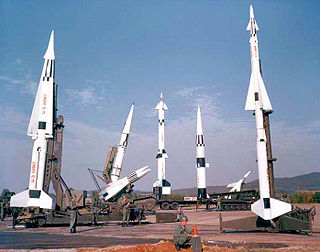 W
WProject Nike was a U.S. Army project, proposed in May 1945 by Bell Laboratories, to develop a line-of-sight anti-aircraft missile system. The project delivered the United States' first operational anti-aircraft missile system, the Nike Ajax, in 1953. A great number of the technologies and rocket systems used for developing the Nike Ajax were re-used for a number of functions, many of which were given the "Nike" name . The missile's first-stage solid rocket booster became the basis for many types of rocket including the Nike Hercules missile and NASA's Nike Smoke rocket, used for upper-atmosphere research.
 W
WNike Zeus was an anti-ballistic missile (ABM) system developed by the US Army during the late 1950s and early 1960s that was designed to destroy incoming Soviet intercontinental ballistic missile warheads before they could hit their targets. It was designed by Bell Labs' Nike team, and was initially based on the earlier Nike Hercules anti-aircraft missile. The original, Zeus A, was designed to intercept warheads in the upper atmosphere, mounting a 25 kiloton W31 nuclear warhead. During development, the concept changed to protect a much larger area and intercept the warheads at higher altitudes. This required the missile to be greatly enlarged into the totally new design, Zeus B, given the tri-service identifier XLIM-49, mounting a 400 kiloton W50 warhead. In several successful tests, the B model proved itself able to intercept warheads, and even satellites.
 W
WNike-X was an anti-ballistic missile (ABM) system designed in the 1960s by the United States Army to protect major cities in the United States from attacks by the Soviet Union's intercontinental ballistic missile (ICBM) fleet during the Cold War. The X in the name referred to its experimental basis and was supposed to be replaced by a more appropriate name when the system was put into production. This never came to pass; in 1967 the Nike-X program was canceled and replaced by a much lighter defense system known as Sentinel.
 W
WNike Zeus was an anti-ballistic missile (ABM) system developed by the US Army during the late 1950s and early 1960s that was designed to destroy incoming Soviet intercontinental ballistic missile warheads before they could hit their targets. It was designed by Bell Labs' Nike team, and was initially based on the earlier Nike Hercules anti-aircraft missile. The original, Zeus A, was designed to intercept warheads in the upper atmosphere, mounting a 25 kiloton W31 nuclear warhead. During development, the concept changed to protect a much larger area and intercept the warheads at higher altitudes. This required the missile to be greatly enlarged into the totally new design, Zeus B, given the tri-service identifier XLIM-49, mounting a 400 kiloton W50 warhead. In several successful tests, the B model proved itself able to intercept warheads, and even satellites.
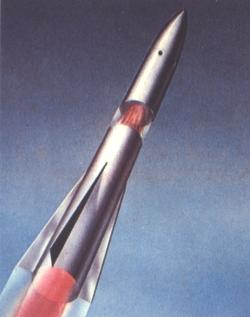 W
WProject Wizard was a Cold War-era anti-ballistic missile system to defend against short and medium-range threats of the V-2 rocket type. It was contracted by the US Army Air Force in March 1946 with the University of Michigan's Aeronautical Research Center (MARC). A similar effort, Project Thumper, started at General Electric.
 W
WRIM-7 Sea Sparrow is a U.S. ship-borne short-range anti-aircraft and anti-missile weapon system, primarily intended for defense against anti-ship missiles. The system was developed in the early 1960s from the AIM-7 Sparrow air-to-air missile as a lightweight "point-defense" weapon that could be retrofitted to existing ships as quickly as possible, often in place of existing gun-based anti-aircraft weapons. In this incarnation, it was a very simple system guided by a manually aimed radar illuminator.
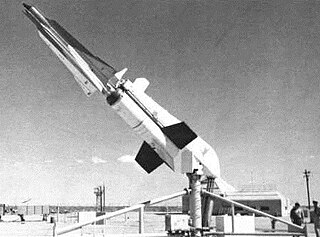 W
WTyphon was a missile system developed by the United States Navy in the late 1950s, intended to serve as an integrated air-defense system for Navy fleets. Consisting of the SAM-N-8 Typhon LR, later designated RIM-50A, and the SAM-N-9 Typhon MR, later RIM-55A, paired with the AN/SPG-59 radar system, the cost and expense of the Typhon system led to it being cancelled in favor of the Standard Missile program.
 W
WThe Convair RIM-2 Terrier was a two-stage medium-range naval surface-to-air missile (SAM), and was among the earliest surface-to-air missiles to equip United States Navy ships. It underwent significant upgrades while in service, starting with a beam-riding system with 10-nautical-mile (19 km) range at a speed of Mach 1.8, and ending as a semi-active radar homing system with a range of 40 nmi (74 km) at speeds as high as Mach 3. It was replaced in service by the RIM-67 Standard ER (SM-1ER).
 W
WThe Bendix RIM-8 Talos was a long-range naval surface-to-air missile, and was among the earliest surface-to-air missiles to equip United States Navy ships. The Talos used radar beam riding for guidance to the vicinity of its target, and semiactive radar homing (SARH) for terminal guidance. The array of four antenna which surround the nose are SARH receivers which functioned as a continuous wave interferometer. Initial thrust was provided by a solid rocket booster for launch and a Bendix ramjet for flight to the target with the warhead serving as the ramjet's compressor.
 W
WThe General Dynamics RIM-24 Tartar was a medium-range naval surface-to-air missile (SAM), and was among the earliest surface-to-air missiles to equip United States Navy ships. The Tartar was the third of the so-called "3 T's", the three primary SAMs the Navy fielded in the 1960s and 1970s, the others being the RIM-2 Terrier and RIM-8 Talos.
 W
WThe RIM-66 Standard MR (SM-1MR/SM-2MR) is a medium-range surface-to-air missile (SAM), with a secondary role as anti-ship missile, originally developed for the United States Navy (USN). A member of the Standard Missile family of weapons, the SM-1 was developed as a replacement for the RIM-2 Terrier and RIM-24 Tartar that were deployed in the 1950s on a variety of USN ships. The RIM-67 Standard (SM-1ER/SM-2ER) is an extended range version of this missile with a solid rocket booster stage.
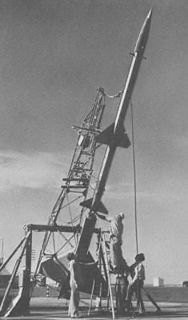 W
WBoeing's Ground-to-Air Pilotless Aircraft (GAPA) was a short-range anti-aircraft missile (SAM) developed in the late 1940s by the US Army Air Force, and then the US Air Force after 1948. It was given the reference number SAM-A-1, the first Surface-to-Air Missile (SAM) in the 1947 tri-service designation system. By 1950 over 100 test rockets had been launched using a variety of configurations and power plants, with one launch in 1949 setting the altitude record for a ramjet powered vehicle at 59,000 ft (18,000 m).
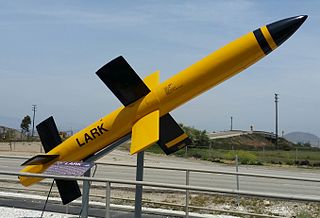 W
WThe Lark project was a solid-fuel boosted, liquid-fueled surface-to-air missile developed by the United States Navy to meet the kamikaze threat. It was developed as a crash program to introduce a medium-ranged defensive layer that would attack targets between the long-range combat air patrols and short-range anti-aircraft artillery. This produced a design with roughly 30 miles (48 km) maximum range and subsonic performance, suitable for attacks against Japanese aircraft.
 W
WSentinel was a proposed US Army anti-ballistic missile (ABM) system designed to provide a light layer of protection over the entire United States, able to defend against small ICBM strikes like those expected from China, or accidental launches from the USSR or other states. The system would have seventeen bases, each centered on its Missile Site Radar (MSR) and a computerized command center buried below it. The system was supported by a string of five long-range Perimeter Acquisition Radars (PAR) spread across the US/Canada border area and another in Alaska. The primary weapon was the long-range Spartan missile, with short range Sprint missiles providing additional protection near US ICBM fields and PAR sites. The system would initially have a total of 480 Spartan and 192 Sprint missiles.
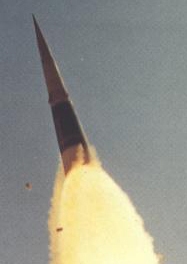 W
WThe Sprint was a two-stage, solid-fuel anti-ballistic missile (ABM), armed with a W66 enhanced-radiation thermonuclear warhead used by the United States Army. It was designed to intercept incoming reentry vehicles (RV) after they had descended below an altitude of about 60 kilometers, where the thickening air stripped away any decoys or radar reflectors and exposed the RV to observation by radar. As the RV would be traveling at about 5 miles (8.0 km) per second, Sprint had to have phenomenal performance to achieve an interception in the few seconds before the RV reached its target.